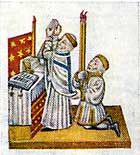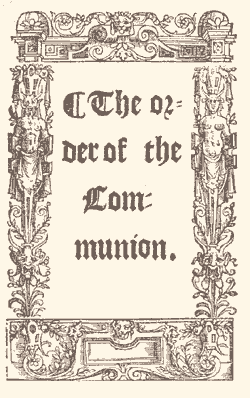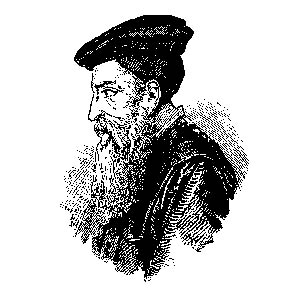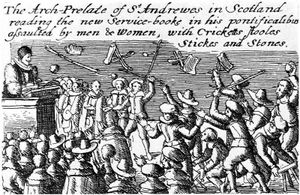Links and resources
Prayer book resources from the Society of Archbishop Justus, and Anglican Resources Collection.
The Sarum missal, in English.
The 1549 Book of Common Prayer.
The 1552 Book of Common Prayer.
The 1662 Book of Common Prayer.
The 1928 U.S. Book of Common Prayer.
The 1959 (/1962) Canadian Book of Common Prayer.
The 1979 (current) edition of the Prayer Book in the Episcopal Church in the USA.
The 2004 Book of Common Prayer of the Church of Ireland.
Prayer Book Society of Canada, home page.
About the Book of Common Prayer, from Wikipedia.
A bibliography from William Petersen.
Changes in English worship to 1552
Before the 1540s the common Sunday worship for most
Christians in England was the
 mass.
The language was in Latin, and most of the action at the altar was hidden
from the people by a screen. People didn't ordinarily take communion.
The most common rite in England was
the Sarum
rite (the Latin word for Salisbury). The decisions made by the
king and parliament between 1529 and 1536 about the jurisdiction of the pope
didn't change this pattern. People continued to go to their parish
church and hear the same liturgy read by the same priest. The main
change in the late 1530s, was that a copy of the English Bible was put into
many churches.
mass.
The language was in Latin, and most of the action at the altar was hidden
from the people by a screen. People didn't ordinarily take communion.
The most common rite in England was
the Sarum
rite (the Latin word for Salisbury). The decisions made by the
king and parliament between 1529 and 1536 about the jurisdiction of the pope
didn't change this pattern. People continued to go to their parish
church and hear the same liturgy read by the same priest. The main
change in the late 1530s, was that a copy of the English Bible was put into
many churches.
Liturgical principles of the Reformation were garnering support. They included:
- an English liturgy;
- visible liturgical action;
- more frequent communion of the people;
- more preaching at the liturgy;
- elimination from liturgical texts of certain theological themes regarded as un-scriptural, such as priestly sacrifice, transubstantiation, and invocations of saints;
- elimination of ceremonies and practices regarded as un-scriptural, such as masses for the dead, and the blessing of most objects (such as ashes on Ash Wednesday).
In the early 1540s the government circulated an English litany for general use. With a few changes, this litany is in our Canadian Book of Common Prayer of 1959.
After 1547,
 when
Edward VI became king and his Protestant-oriented council took control,
serious liturgical change became politically feasible. In 1548, an
English "order for communion" was published. Clergy could insert it
into the Latin mass. It authorized communion in both bread and wine.
when
Edward VI became king and his Protestant-oriented council took control,
serious liturgical change became politically feasible. In 1548, an
English "order for communion" was published. Clergy could insert it
into the Latin mass. It authorized communion in both bread and wine.
The first Book of Common Prayer, 1549, and Ordinal, 1550. On Whitsunday 1549, a book of public services was ordered by statute to be used in all churches. The book included daily public services of Morning Prayer ("the common prayer") modelled on the medieval Latin morning offices, as modified by certain Catholic and Lutheran churches. It included the reading of one chapter from the Old Testament and one from the New, followed on most days by the English Litany slightly revised. Then came the Lord's Supper, or Holy Communion, "commonly called the Mass", a service adapted from the most common Latin mass service in England, but with important changes and the inclusion of all the material from the Order of Communion of 1548. An Evening Office, similar to Morning Prayer, was also provided, together with services for the Baptism of Infants, a brief Catechism, and Confirmation Service, a Marriage Service and a Burial Office. Bishop Coverdale's English Version of the Psalms was bound in the same volume. The vestments of the clergy were simplified, but most of the medieval vestments for the clergy and chancels were retained. In 1550, a separate service of ordination of Bishops, Priests and Deacons was also published and authorized.
The second Book of Common Prayer and Ordinal, 1552. On All Saints' Day 1552, a second edition of the Book of Common Prayer, together with the Psalter and Ordinal, was imposed by a new Statute of Uniformity. This version retained a good deal of the material and wording of the first version, but with substantial re-ordering of the material in the Communion Services. Other changes included:
-
 the
omission of all the portions that a traditionalist critic,
Stephen Gardiner, bishop of Winchester,
pictured right,
had particularly affirmed in the 1549 book; and
the
omission of all the portions that a traditionalist critic,
Stephen Gardiner, bishop of Winchester,
pictured right,
had particularly affirmed in the 1549 book; and - the acceptance of about half the changes recommended by a German friend of the English Reformation, Martin Bucer, who had been teaching in Cambridge until his death in 1551;
- a new penitential rite was added to the beginning of Morning Prayer;
- simplification of the vestments of the clergy : only the surplice would be allowed, except in colleges and cathedrals;
- ending of Communion of the Sick from the reserved sacrament, and of provision for a celebration of the Eucharist at burials.
After the first printing of the book, and its approval, a rubric ("the Black Rubric") was added to the Communion Service, defending the provision that Communion be received kneeling and affirming that Christ's body and blood were not present in the elements of the eucharist.
Subsequent Prayer Book history
From 1553 to 1557 the Prayer Book was outlawed and the mass restored under Queen Mary, a Roman Catholic.
The Elizabethan settlement of religion brought a new edition of the Prayer Book (1559), which was just a modest revision of 1552, and certain guidelines and regulations aimed towards a greater liturgical uniformity in England.
 In
1637 some Anglican leaders
revised the Prayer Book in a 1549 direction and unsuccessfully sought to
impose it on Scotland. At Edinburgh, a riot ensued. It
contributed to civil war. The 1637 book later became something of a
model for Anglican liturgical revisers who thought that 1552 was too
Protestant.
In
1637 some Anglican leaders
revised the Prayer Book in a 1549 direction and unsuccessfully sought to
impose it on Scotland. At Edinburgh, a riot ensued. It
contributed to civil war. The 1637 book later became something of a
model for Anglican liturgical revisers who thought that 1552 was too
Protestant.
From 1645 to 1660, when Oliver Cromwell controlled the English government, the Prayer Book was banned. Since there were no Anglican confirmations during this time, the rule that only confirmed Anglicans could take communion had to be relaxed.
In 1662, as part of the Restoration of the monarchy and a conservative reaction against Cromwell's period, a new statute of uniformity was passed, requiring the use of a new revision of the Prayer Book. The 1662 book remains in use in the Church of England, though many alternative liturgies are permitted.
With the spread of Anglican Christianity around the globe, connected with the rise of the British Empire, local prayer books were published. Some were in the 1549 family of liturgies (including Scotland and the United States), some in the 1552 family (such as Ireland and Canada).